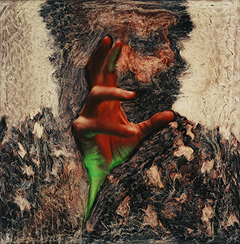 |

 |
 |
Self Portrait, Charles Samuel Keene, British, about 1845
|
 |
 |
|
Investigating issues of artistic identity and image-making, this exhibition looks at some of the ways in which artists have represented themselves, their fellow artists, their activity, or their surroundings over the past five centuries. Images of the Artist presents varied media: mostly drawings, but also prints, photographs, paintings, and sculptures from the Getty's collections, complemented by loans from local institutions and private collectors.
Charles Keene's self-portrait is deeply shadowed on one side and brightly illuminated on the other. The young artist's face emerges from a network of meticulous, at times extremely dense lines known as "hatching"—a technique he developed in the etchings he made during his concurrent apprenticeship to two book illustrators. Keene was primarily known for his illustrations in satirical journals such as Punch. He never exhibited this self-portrait, which looks unfinished by the standards of his day.
|
 |
|
Portraits can do more than immortalize the likeness of a sitter. They may also construct, project, or perpetuate a certain perception of the sitter or their position in society. Additionally, they may convey something about the rapport between the portraitist and sitter, display the maker's skill, or merely experiment with technique or style. In the case of self-portraits, the artist and sitter are one, further complicating attempts to view this kind of representation as an objective account. In addition to their potential for self-presentation, such images have served as a potent means of self-exploration.
In Carriès's dark, highly unorthodox self-portrait, he has depicted himself with the donkey ears of Midas, a mythological king known for his foolishness. At the same time, the disembodied head – without the neck usually shown in portrait busts – suggests the dominance of the spirit and intellect over the body. This duality plays out further in the contrast between the almost ethereal facial expression and the earthy patina, or surface treatment, of the painted plaster, which resembles bronze. As an artist, Carriès was very particular about the surface and finish of his sculptures, as if they were made less to be seen than to be touched.
|
 |
|
Artists have used allegory – or the use of symbolic figures to embody abstract ideas – to represent artists and artistic creation since the Renaissance. The visual vocabulary of allegory, however, has its roots in classical antiquity. Several powerful myths of artistic creation originated in ancient Greece, including the myth of Pygmalion and Galatea. Frequently used to elevate the artist and his work, allegory also leaves room for parody. This was especially the case in the nineteenth century, when society questioned time-honored traditions and ways of thinking about the artist's role and status.
In ancient Greek myth, Pygmalion fell in love with a statue he had created, which was then brought to life for him as a woman named Galatea. In this drawing, Goya's take on the story is irreverent. He depicts the legendary sculptor (whose face might be that of Goya himself) wielding a hammer and chisel on Galatea, but she appears more alarmed than amorous. A sense of the hard, unglamorous labor necessary to carve a sculpture replaces the mythical magic of its creation and transformation. Goya also reverses the order of events: Galatea has already come to life, but Pygmalion has yet to become enamored with her.
|
 |
|
The Romantic conception of the artist is as an isolated, tortured genius. As a result, we often tend to picture artists toiling alone in sparsely furnished studios. While countless such depictions certainly exist, some images give a more varied view. Social interaction is a significant aspect of their lives, whether with patrons, teachers, fellow artists, or students. Still, the prevalence of images of artists alone in front of an easel or sketchbook suggests that their work is ultimately a lonely pursuit.
This image comes from a series illustrating the early life and education of the artist's older brother, Taddeo Zuccaro (Italian, 1529-1566). Here Taddeo is shown as a young apprentice to an established artist in Rome. Restricted to menial tasks during the day and not allowed a lamp at night, he has such a strong desire to draw that he works by moonlight after the rest of the household has gone to bed. Although somewhat romanticized, this scene gives a vivid impression of the realities of an aspiring artist's life during the Renaissance.
|
 |
 |

 |
 |
Photo-Transformation, Lucas Samaras, American, November 22, 1973
|
 |
This final section of the exhibition displays images in which the artist's likeness and presence are more elusive than in the other works on view. While the artist's body may be fragmentary, distorted, or simply absent in these works, they bear tangible traces of the artist and the physical or mental process of image-making – be it in fingerprints or shadows.
The photographer Lucas Samaras has continually used himself as a subject for his art. In this self-portrait, he manipulated the highly malleable wet dyes of a Polaroid print to create one of his so-called photo-transformations. Heavily distorted, his body has largely disappeared except for his crisply defined hand, which curls forward from the amorphous background. It is as if the reclusive artist, trapped in a world of his own making, were reaching out to the viewer. The sense of claustrophobia is underscored by the diminutive format of the Polaroid print.
|
 |




